I haven’t been this excited about photographing a bird in a very long time (more about why that’s true at the end of this post if you have the stamina to get through it…).
The Green-tailed Towhee was my spark species, the one that ignited my interest in and passion for native birds and for me that happened almost 50 years ago. But these are extremely elusive birds and since I took up bird photography 10 years ago I’ve never been able to get close to the species. I have less than a handful of “acceptable” images of them and that’s about it.
But yesterday morning I decided to escape the heat of the valley and head up into the nearby Wasatch Mountains to see what I could find. This single bird made my day. Hell, he came pretty close to making my year.
1/8000, f/6.3, ISO 800, Canon 7D Mark II, Canon EF 500mm f/4L IS II USM + EF 1.4 III Extender, not baited, set up or called in
This is the first shot, out of almost 1500, I took of the male Green-tailed Towhee (based on my shutter speed I obviously hadn’t yet had time to adjust my settings) who was often singing on territory but very far away. At this point I considered it a success just to see him and get some documentary photos.
But then a near-miracle happened.
1/2500, f/6.3, ISO 500, Canon 7D Mark II, Canon EF 500mm f/4L IS II USM + EF 1.4 III Extender, not baited, set up or called in
He flew in and landed so close to my pickup that I had to compose carefully to get him all in the frame. I literally couldn’t believe this elusive species came in that close and stayed close for as long as it did.
Because of the distracting foreground elements I’m only including this shot to show you how close he came – this photo is full frame (uncropped).
1/4000, f/6.3, ISO 640, Canon 7D Mark II, Canon EF 500mm f/4L IS II USM + EF 1.4 III Extender, not baited, set up or called in
And after that he teased and beguiled me by landing on many close perches that were sometimes less than ideal but gave me a detailed look at the bird.
1/1250, f/6.3, ISO 640, Canon 7D Mark II, Canon EF 500mm f/4L IS II USM + EF 1.4 III Extender, not baited, set up or called in
This photo is almost identical to the previous one but I’m including it because a passing cloud had darkened the hillside in the background and I thought the contrast between the two images (not to mention the dramatically different shutter speeds) was interesting.
1/3200, f/6.3, ISO 400, Canon 7D Mark II, Canon EF 500mm f/4L IS II USM + EF 1.4 III Extender, not baited, set up or called in
He even landed on a photogenic perch or two that gave me a clear look at the bird.
1/3200, f/6.3, ISO 500, Canon 7D Mark II, Canon EF 500mm f/4L IS II USM + EF 1.4 III Extender, not baited, set up or called in
But he seemed to be particularly fond of this gnarly old twig. Everywhere he landed he was singing on territory and when he was perched close to me the inside of my pickup seemed to be flooded with his song. Many of his songs can be heard here if you have the interest.
1/1600, f/8, ISO 500, Canon 7D Mark II, Canon EF 500mm f/4L IS II USM + EF 1.4 III Extender, not baited, set up or called in
Once again the hillside in the background became shaded and that sort of spotlighted the bird as he turned and gave me several nice poses.
1/2000, f/8, ISO 500, Canon 7D Mark II, Canon EF 500mm f/4L IS II USM + EF 1.4 III Extender, not baited, set up or called in
To my eye several of these photos appear to be on the verge of being over-sharpened which puzzles me a little. By the nature of the beast virtually all images shot in RAW need at least some sharpening but I’ve applied less than 50% of the amount of sharpening to most of these shots than I normally do and some of them still seem a little crispy. Perhaps I should have applied no sharpening at all…
1/3200, f/7.1, ISO 500, Canon 7D Mark II, Canon EF 500mm f/4L IS II USM + EF 1.4 III Extender, not baited, set up or called in
A couple of times the breeze caught the back of his red cap and raised it so that the back of it looked like it had been cut vertically by a deranged barber and that amused me.
1/3200, f/7.1, ISO 500, Canon 7D Mark II, Canon EF 500mm f/4L IS II USM + EF 1.4 III Extender, not baited, set up or called in
The sexes are similar in this species but I know this bird to be a male because females don’t sing.
Soon after this shot was taken he flew across the road so I left the area. I’d spent 50 minutes with this bird and taken roughly 1500 shots of him and that blew me away considering their shyness and my past record with the species.
Occasionally I like to include a wide-angle view of the setting so viewers can get a better sense of place. Sharp eyes will spot the towhee at the top of the bush at bottom center.
Ok, I suspect some readers may be wondering why I was so excited to finally get some quality shots of a Green-tailed Towhee so I’ll include an explanation.
Way back in the spring of 1969 I was a 21 year-old Senior at the University of Utah enrolled in the Ornithology class of the legendary Dr. William H. Behle. A field study of a local bird species was a requirement for the course but I was a freshly-planted Montana farm boy who knew virtually nothing about Utah birds and where to find them so I was at a loss as to which species to choose. One of the teaching assistants suggested that I choose the Green-tailed Towhee and I went with it (if I’d known how shy they are I probably would have gone with some other species).
I spent dozens of hours over several weeks looking for towhees in a small mountain valley similar to (and quite close to) this one and armed with only a pair of cheap binoculars and a notebook. The towhees were there but because of their secretive nature I rarely got close to them. Only twice was I close enough to get a good look at a male singing on territory and it was then that I realized that they were colorful, beautiful birds rather than “just” another LBJ (little brown job). I was intrigued.
My time spent in the field with those towhees hooked me and I’ve been fascinated by birds ever since. They were truly my spark species.
Ron


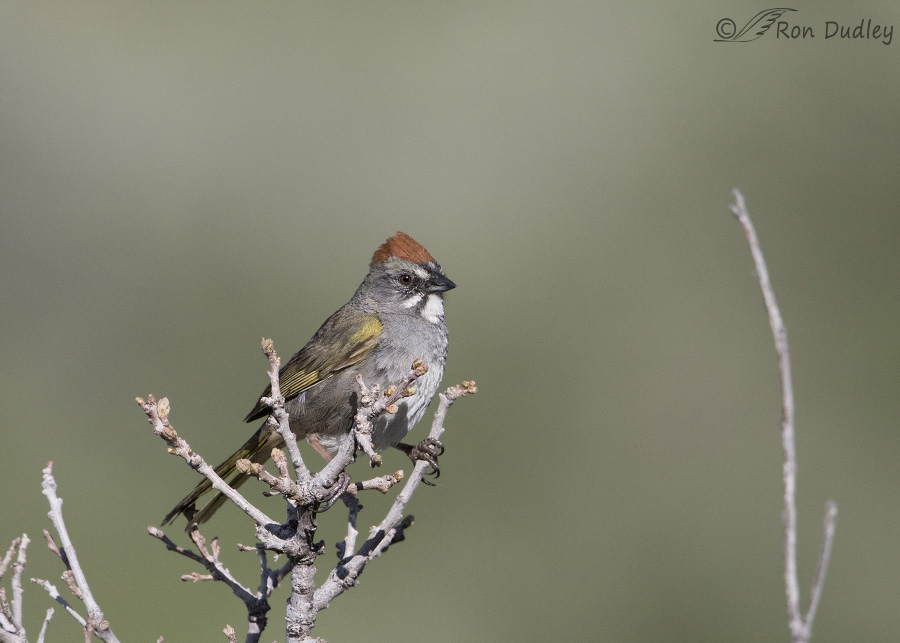
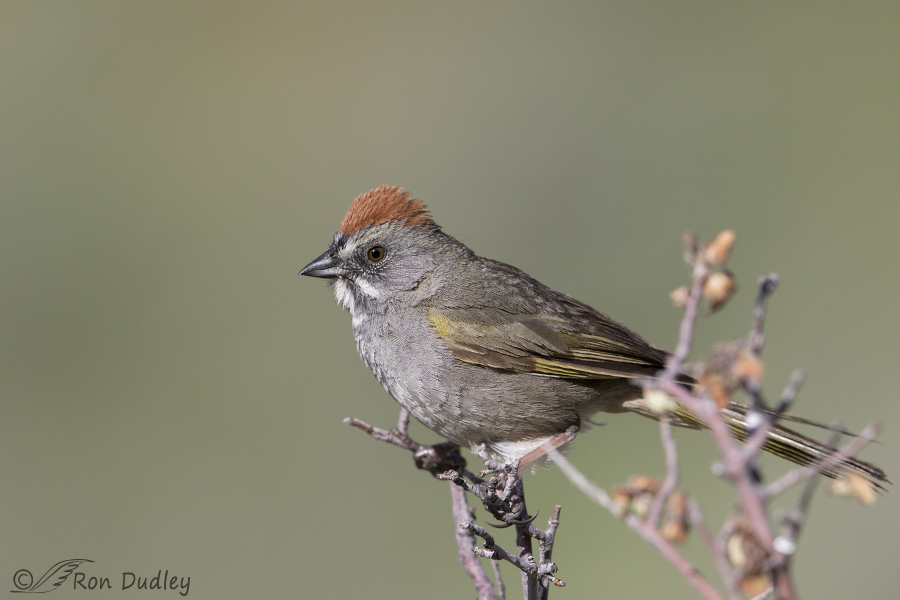
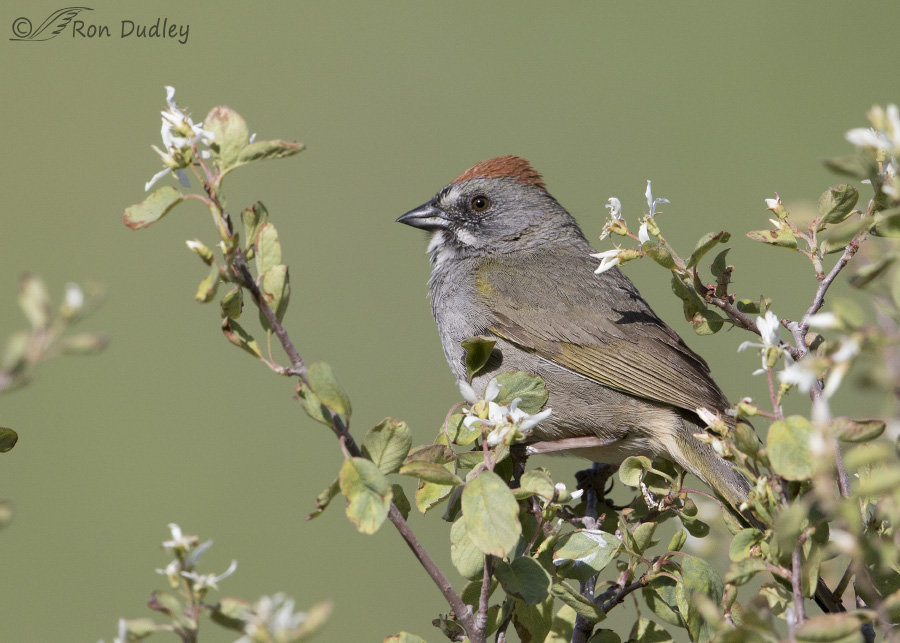
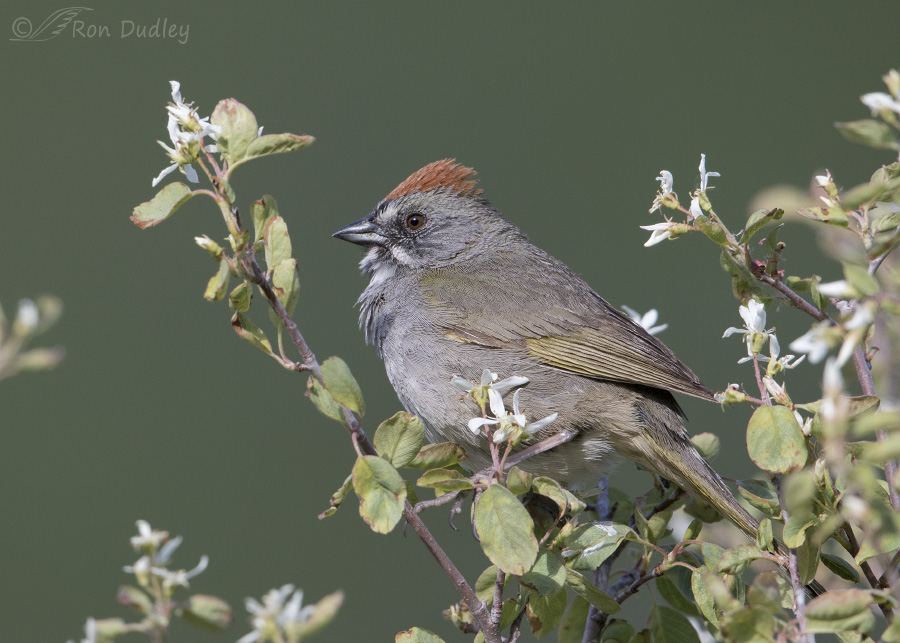
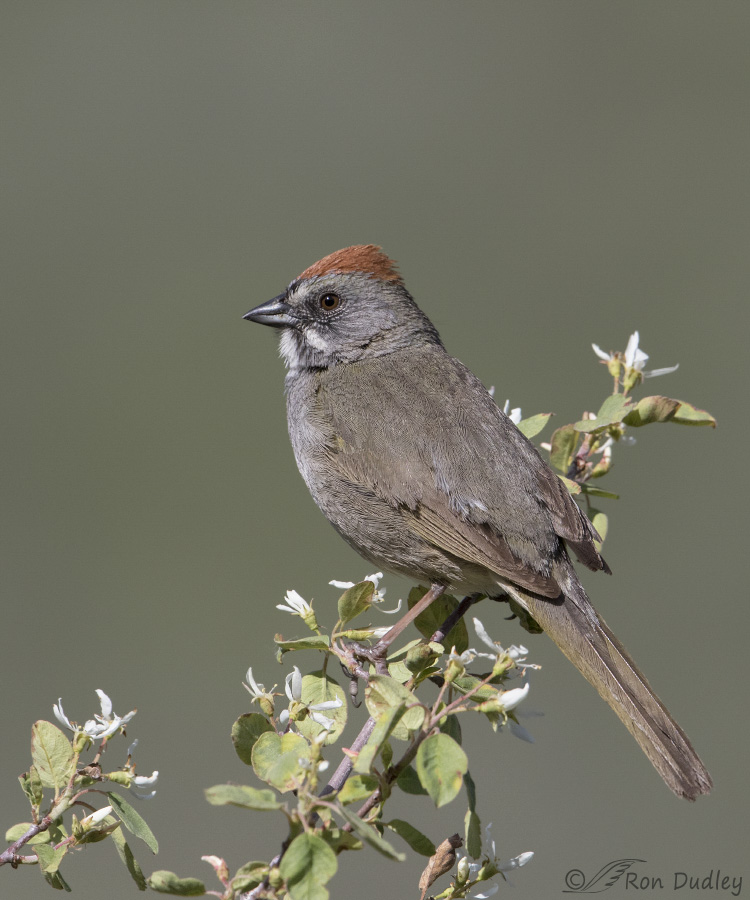
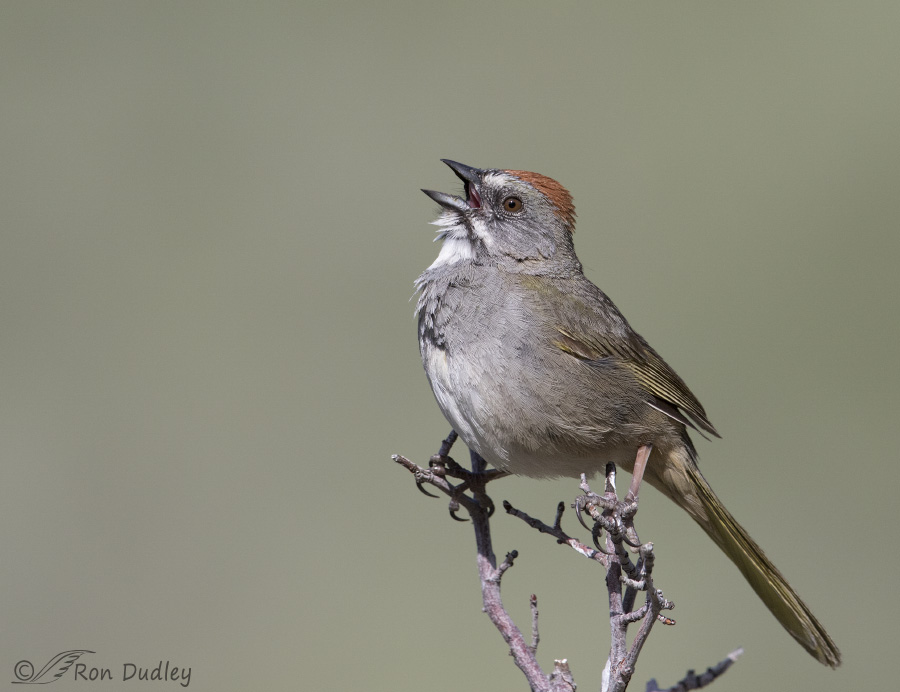
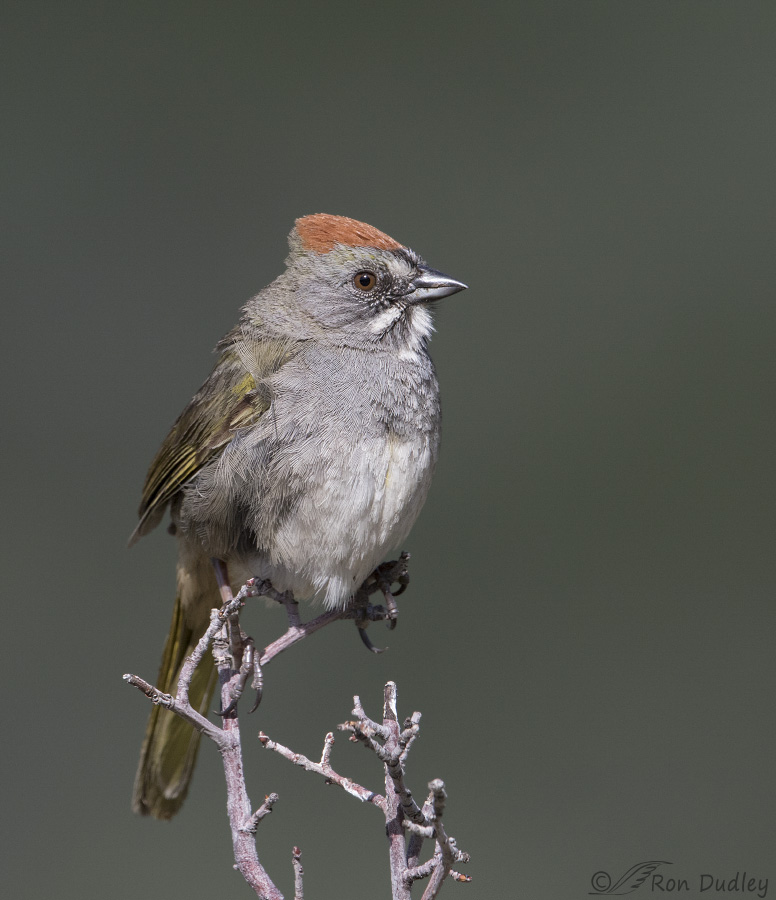
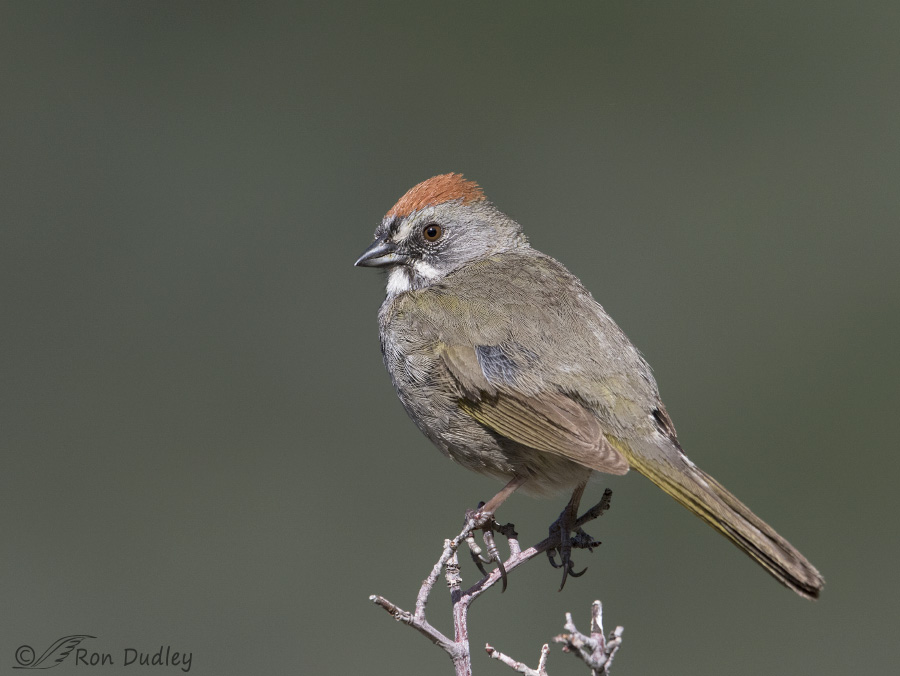
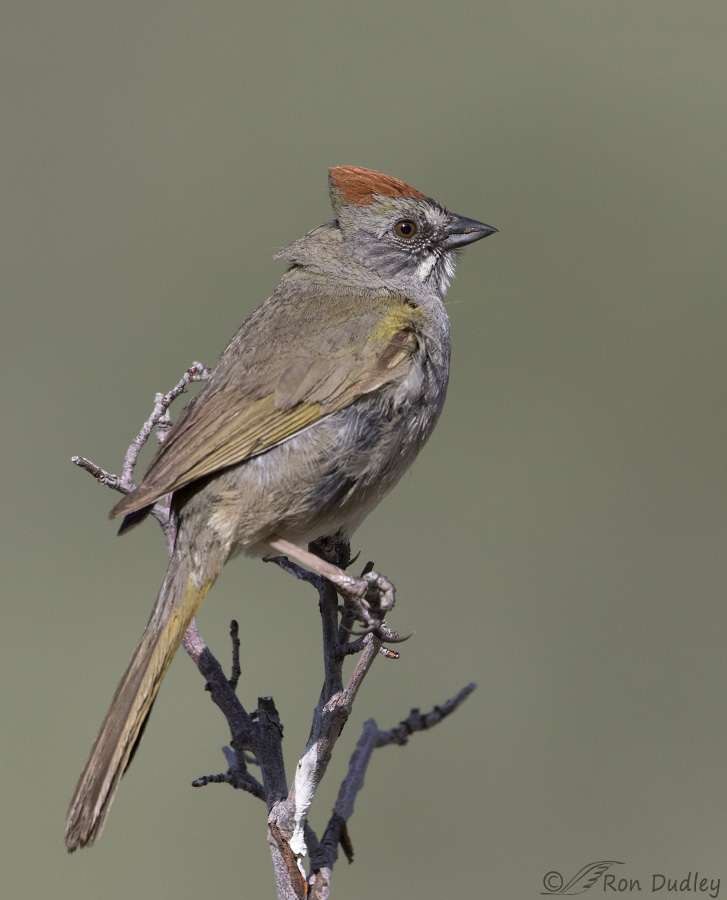
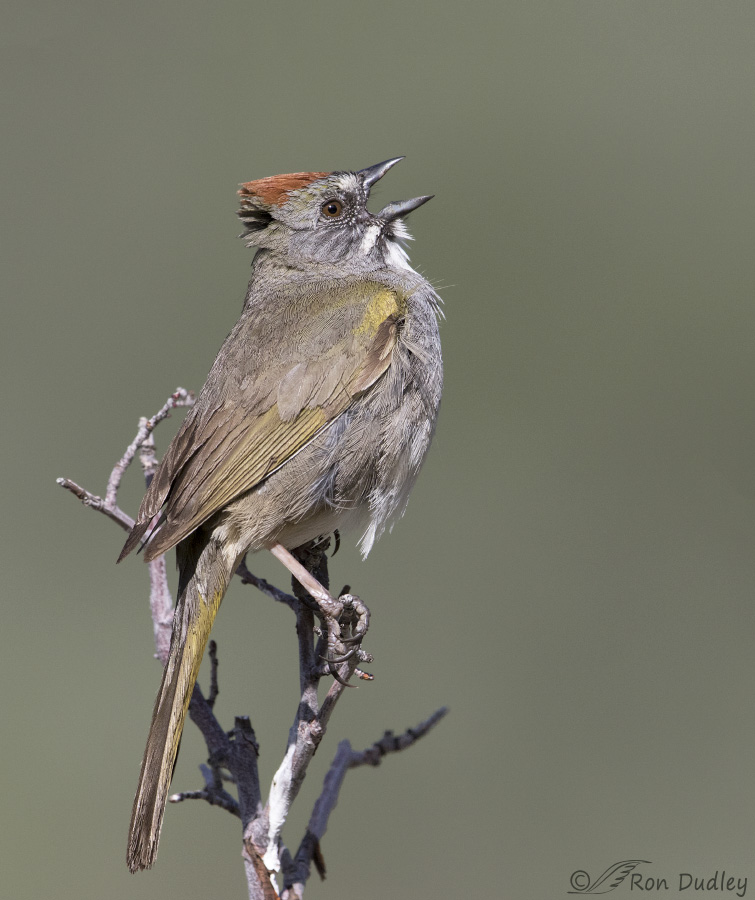
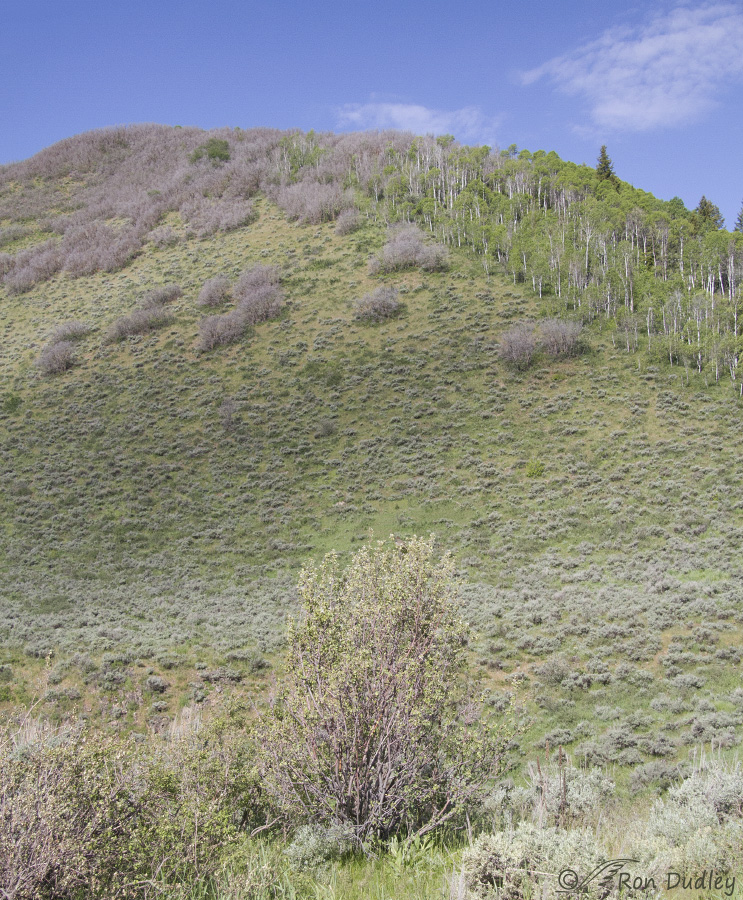
Beautiful photos, Ron! So fun to see the progression from one perch to another, the views just kept getting better! And thanks for noting the change in background colour due to the shaded/unshaded hillside – very neat. I’ve never seen one of these birds; the wing and tail feathers have such an interesting variety of coppery, yellow, green, beige and grey shades which all shimmer so beautifully in your photos! And I always appreciate the context photos. 🙂
Late to the party, Ron, but what a great post! Towhees have so much personality and I’m delighted that this bird was so cooperative for you. Thanks for sharing the story behind your “spark”!
Ron,
Beautiful LBJ.
SEC
Thank you, Stephen.
I understand about Green-tailed Towhees. We have them around here, but I’ve only seen one up close enough to identify on one occasion. I went to listen to the songs and when I came back to this page, it was at a shot of the singing bird and I had the bird song in the background. Neat experience. The really elusive species for me in photography has been the Black-tailed Jackrabbit. Today I saw one, and was actually finally able to get some snapshots of it – and they were good enough that one could recognize what it is. I’m glad you had such a wonderful time with the Green-tailed Towhee. Clearly patience pays.
Susan, If you want good close shots of jackrabbits you should visit Antelope Island some day. They’re really quite approachable, especially near the campgrounds.
Susan Stone, for black-tailed jacks, come visit me in Golden Valley, Arizona. They’re all over the place here, and while they’re usually slinking from one hiding place to the next, they’re easily visible in the fields around my house!
Oh that song. To have that filling the car, and the singer filling your eyes must have been AMAZING.
I suspect you were smiling so broadly your face hurt (and that pain is sooo much better than dental nastiness).
Thank you.
And how nice that he chose to mess with your mind in a positive way…
It WAS amazing, EC – and for so long was a bonus. Thank you.
Congratulations, Ron! And what a beautiful animal.
A couple of questions:
– what altitude did you spot this LBJ? Obviously it is a dry-ish environment and not thick forest.
– can you expand on your comments about sharpening? You think that RAW images need a little sharpening by default? What type of sharpening do you do typically and what normal values (amount, radius, detail, masking). Do you think these parameters are important in your sharpening? And finally, how do you decide how sharp to make it?
I also sharpen, a little, all of my images in post. I always wondered if it was needed due to softness of the lens, inadequate focusing on my part or just part of the RAW processing.
Thanks.
Art, this towhee was photographed at an elevation very close to 5800′.
I don’t know the physics of it but I’ve read time and time again that RAW files need at least some sharpening and my eye tells me the same thing so I do it. Default camera settings often do some sharpening to jpegs but that doesn’t affect RAW files.
I often mask my subject before sharpening to prevent sharpening halos. My Unsharp Mask settings are: amount – 100%, radius- .3, threshold 0. I sharpen till it “looks right” – there’s no magic formula for that…
Loved these photos, professor. What a striking bird!
Thank you, Arwen – for the compliment and for the promotion!
I love this series! Bird and setting are wonderful…each one better than the last…impossible to pick a favorite…listened to all song tapes….such a happy-sounding bird! And beautiful to look at, too…..
Patty, I think those songs were going through my head for the entire drive home yesterday!
I just congratulated Mia on her series of that Green-tailed Towhee and the same OH WOW superlatives go to you, too. What a treat to find this lovely bird and that he sang just for you guys! I’ve never seen this bird before, and with its delightful song, what a special way to begin this day. Thank you SO much for sharing your photography, for going out there to make this happen and your dedication to the whole birding thing 🙂 Just love you guys! You have become such an outrageous blessing, especially now when I’m in an epic battle against severe, chronic pain and the resulting depression. Thank you for bringing more joy into my life! First rheumatologist appointment here is today, so hoping the pain backs off once we get to treating the RA again.
I’m hoping your pain has stopped.
And I hope you can find some relief for your own pain, Laura. Soon!
Fabulous! Bird, photos, background story — all of it! Isn’t it amazing how chance decisions lead to such great results? You picked the exact right day to go to the exact right location to find your towhee. What a fine fellow he is, too, with a beautiful song to sing. And you can’t help but love that “punk rocker” look in those last couple of images. 😎
Yes, timing was everything for this one, Chris!
Ron: Beautiful images of a neat bird. Spark bird? Now I know what that goldfinch was 70 years ago in Crestwood, NY: my spark bird. Lots of birds, travel and photos since; I am very grateful.
Yup, spark bird is what they call it, Richard. Thanks.
The songs are just as amazing to hear as these photos to view. Thanks for sharing.
Thank you, Elmer.
A pleasure to read and beautiful photos. I smiled through the entire article as I was happy for you. Congratulations on a wonderful encounter with an old friend 🙂
I can tell you understand, Zaphir. Thank you.
CONGRATS!!! HOW exciting to get such awesome shots of this beautiful elusive bird! Would make a beautiful collage to hang on your wall. 😃
Charlotte
Thank you, Charlotte. It was a fun morning.
Ron: You’ve captured a wonderful and elusive species nicely. I had never seen a photo of it up until now. Your sequence of shots is outstanding. Gongratulations. I’s great to see how excited you are and I fully understand your sense of achievement.
Thanks for appreciating what was a memorable encounter for me, Ricardo.
Beautiful photos and nicely set up on branches, lovely light and nice background greens to accentuate the green of the Towhee, how lucky you were to find this fine fellow. They are a fast flitting bird. I had one in my large soft release cages for a short time. He was amazing to observer (from a distance, I do not want to stress him while he is in a cage getting ready for release) some of their calls are similar to car alarms.
Thanks, April. I’m glad you were able to release your towhee!
What a jewel-like little creature………I’m so happy for you that you “got” him at last ! I found myself wondering why that TA set you such a challenging mark ? Maybe he guessed intuitively
just how DETERMINED you are, even as a greenhorn !
Perhaps he just wanted to test my mettle, Kris. If so, it worked – for a long time I was quite frustrated because I couldn’t get close to them.
Thank you for sharing your encounter with this delightful bird! I’m so happy for you! 😀 I appreciate the backstory and the link to its songs and calls. I especially like the shots with the darker backgrounds/clouds. The last “scale” shot reinforces just how skilled you are to be able to find that needle in a haystack every time!
And thanks to your “deranged barber” remark, I’m going to have Sweeney Todd ear worms all day. 😉
Ha, perhaps this bird escaped the trap door below the barber chair at the last second because he could fly! 🙂 Thank you, Marty.
This guy obviously felt the love and decided to “Make Your Day!” All of these shots, and especially 5,6,7,8 to me are beautiful portrait shots of this species, this bird, they are simply fantastic!! Outstanding!!
Interesting song – too bad you don’t have a recording of the song from your area. It seems to me that the various songs portrayed from different states were slightly different. It almost suggests that one could tell the state the bird was in by listening to the song.
I certainly understand your excitement – Congratulations!!
Dick, I just tried to look up regional variations in their song on BNA but couldn’t find anything.
Ha, don’t think I’ll be recording songs any time soon. I have trouble enough juggling all my camera gear!
Slacker! 😉
Ha, I wasn’t suggesting that you should, although I did do it for awhile 20 years ago. I was simply wondering about it since it appeared to me that there was a slight difference when I listened to the recorded songs. Someone needs to be more musically endowed than I to be able to research and tell the difference.
Congrats on having a wonderful morning with your “spark” species.:) I’ve never seen one tho the environment says they should be up around Ft. Benton at least! Wonderful series – light changes certainly do make a difference in both the photos and what shutter speed ends up being.
Judy, My range map suggests they may be found a little east of you. I don’t recall having ever seen them during my years growing up in nw MT.
AWESOME pics and story! I am so happy for you. This is just reward for years of patient dedication. Thanks for sharing and continuing to inspire.
Thank you, Robert. It was a long time coming but worth the wait!
Beautiful series…congratulations!
Thank you, LS.
Beautiful photos and a nice story about your spark species! My spark to bird watching happened about 4 yrs ago when I was hiking in the woods and a brown creeper appeared out of nowhere (it seemed to me) and bounced around a pine tree. I had never noticed one before and he was so close I could see all his fancy brown and white feathers – like a jewel in camouflage! A few years later I was trying to photograph birds with an sx50! I am quite fond of LBJs and I find that even the plainest birds are quite spectacular when you look at them up close – it’s one of the joys we get from viewing your wonderfully sharp photos! (Not that you usually photograph plain birds.) Again, thanks for sharing!
“I find that even the plainest birds are quite spectacular when you look at them up close”
That is so, so true, Joanne! Thank you.
Fabulous series, Ron! Congratulations – I can understand why you were so excited.
Nancy, It was a fun morning and this towhee was the reason why.